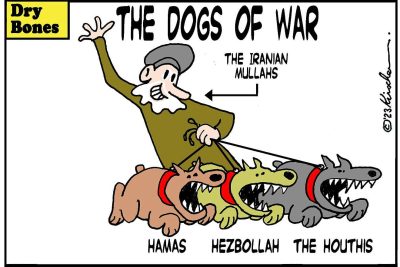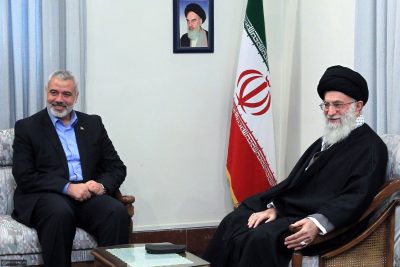
by: Ilse Strauss, News Bureau Chief
In the aftermath of October 7, as Israel battled Hamas in the trenches of Gaza, the world went to war alongside the fighting forces, pitting Israel supporters against Palestinian sympathizers in the trenches of social media. On the ground and in public opinion, the battle lines seemed clearly drawn: Israel on the one side and the Palestinians on the other.
Yet as the hostilities rage past the eight-week mark, Professor Kobi Michael, senior researcher at the Institute for National Security Studies and editor in chief of Strategic Assessment, warns against missing the forest for the trees—and thus diminishing the scope and severity of the conflict.
The war that erupted on October 7, Michael explains, is not a confrontation between Israel and the Palestinians or even Israel and Hamas. Instead, it is a regional war with Israel at the center and Iran as the puppet master working behind the scenes, prompting its terror pawns to strike—all for a specific outcome.
 The Tie that Binds
The Tie that BindsThe Jewish state is currently fighting a multi-front war featuring five active fronts in and around Israel, each with different levels of intensity, Michael says. The most visible and intensive is the Gaza Strip, home of Hamas. Then there’s Judea and Samaria, or the so-called West Bank, where Hamas continues to make inroads and gain support. Further north, there’s south Lebanon, where terror army Hezbollah lurks with its arsenal of up to 300,000 precision missiles. A stone’s throw from there in southern Syria, a number of militias lie in wait, right next to neighboring Iraq, where a pack of other militias prepare to pounce. Finally, there’s the Houthis in Yemen, launching sporadic ballistic missiles at the Jewish state and hijacking ships with supposed links to Israel.
A singular thread links the five fronts together. These terror proxies form the “Axis of Resistance,” a military alliance birthed, groomed, mentored and funded by Iran over four decades to erase the Israeli and American presence from the Middle East.
The existence of the axis is no secret. These proxies have operated both overtly and covertly in the region and beyond for some 40 years. However, October 7 thrust the jihadist alliance into the international spotlight in a chilling new way. For the first time since Iran set out to recruit its regional terror puppets, the axis is mobilizing at the same time on multiple fronts to strike at a single target: Israel. And the future stability of the Middle East—and the Western world beyond—depends on how well Iran’s joint venture fares.
“In essence, this is the second chapter of Israel’s War of Independence,” Michael explains, “with Israel facing an existential threat, not because Hamas or Hezbollah are existential threats, but rather components in a much broader camp or axis of resistance, led by Iran and supported by Russia and China. The war isn’t local, confined to the Gaza Strip or even to Israel and the Palestinians. It is a regional war that has an immediate effect on the entire globe.”
According to Michael, every shot fired in and around the Promised Land echoes into every other area, sphere or industry across the globe, be it Africa, Ukraine or the South China Sea. “This is why the US immediately dispatched a substantial military presence to the region [following October 7] to contain the war and deter Iran from escalating the conflict. It was a clear signal to Israel’s enemies—in the region and beyond—that Washington is serious and committed to the security of its allies.”

The mullahs in Iran have been outspoken about their ambition to annihilate Israel. However, the Jewish state is hardly the final frontier. In fact, Tehran’s aspiration of regional hegemony serves as a prequel to global supremacy, with the “Little Satan” and then the “Great Satan” standing as stepping stones to Iran’s ultimate goal.
Since the 1979 Islamic Revolution, one of the Iranian regime’s key priorities has been exporting the principles, beliefs and practices of the revolution abroad. In other words, Iran’s foreign policy calls for the imposition of Islamic sharia law in both Islamic and non-Islamic countries across the world by means of proselytizing, propaganda and if all else fails, following in the footsteps of the “victorious and triumphant” early Muslim armies who set “out from the mosque to go into battle” in line with the command from the Quran to “prepare against them whatever force you can muster,” Ruhollah Khomeini, the founder of the Islamic Republic of Iran wrote.
In the 40 years since the revolution, Iran has been hard at work answering Khomeini’s call. Today, Tehran boasts more than a dozen militias and terror groups across the Middle East with outposts around the world. All these proxies are funded, trained and answerable to Iran’s Islamic Revolutionary Guard Corps, a paramilitary body born in 1979 to protect Iran’s fundamentalist regime. And all these proxies are ready and eager to set “out from the mosque to go into battle” to export the principles, beliefs and practices of Iran’s glorious revolution abroad, ultimately gathering all nations under the iron fist of Islam. And with several of these proxies, including Hamas, Hezbollah and the Houthis, perched within striking distance from the Promised Land, there’s no doubt that the mullahs have Israel in their crosshairs as the next—but certainly not the last—target.
“I strongly recommend that everybody listens carefully to what the leaders of Iran, Hamas, Hezbollah and the other members of the axis have said in the past and continues to say today,” Michael warns. “They admit that the destruction of the State of Israel is the first phase. The second phase will be Berlin, Paris and New York. And October 7 stands as proof that there is no difference between their words and their actions. October 7 stands as proof that we can take them seriously.”
News headlines and social media will continue to focus on the here and now, on the localized conflict in the Gaza Strip, aiming to present this fight as a separate, individual clash with no international ramifications. We are called to see the bigger context though. This is not a fight between Israel and the Palestinians or even Israel and Hamas. This is a fight between the forces of light and darkness; good and evil; freedom and slavery. Israel is not only fighting an existential threat. The Jewish state is in a battle on behalf of the free world.
Photo Credit: Click on photo for photo credit
Photo License: Hamas leader Ismail Haniyeh meeting Iranian Supreme Leader Ali Khamenei
All logos and trademarks in this site are property of their respective owner. All other materials are property of Bridges for Peace. Copyright © 2025.
Website Site Design by J-Town Internet Services Ltd. - Based in Jerusalem and Serving the World.